
Photo from wikipedia
Abstract BACKGROUND Tillage operations will change the distribution in soil for any pesticide residues still present from earlier applications. This redistributive effect of tillage has been neglected in the study… Click to show full abstract
Abstract BACKGROUND Tillage operations will change the distribution in soil for any pesticide residues still present from earlier applications. This redistributive effect of tillage has been neglected in the study of pesticide leaching behavior. This study reviews the literature to characterize this redistributive effect for different tillage operations and uses a pesticide leaching model to investigate the impact of redistribution on pesticide transport to subsurface drains which is a significant input route to surface water bodies. RESULTS Inversion ploughing moves the majority of any residues of pesticide present at or near the soil surface into the bottom two‐thirds of the plough layer, whereas non‐inversion ploughing has only a limited redistributive effect. Incorporating this redistributive effect into model simulations resulted in large changes (typically 5–10‐fold difference) in both the maximum concentration and total mass of pesticide transported to drains over the winter following cultivation. More intense cultivation decreased subsequent leaching for relatively mobile compounds (Koc ≤1000 mL g−1), but increased it for strongly sorbed pesticides (Koc ≥2000 mL g−1). CONCLUSION The redistributive effect of soil tillage on pesticide residues can have a large effect on subsequent transport to subsurface drains. This effect has been neglected in the literature. Field research is required to validate the model simulations presented here, and consideration should be given as to whether the effect needs to be included within risk assessment procedures. © 2022 The Authors. Pest Management Science published by John Wiley & Sons Ltd on behalf of Society of Chemical Industry.
Journal Title: Pest Management Science
Year Published: 2022
Link to full text (if available)
Share on Social Media: Sign Up to like & get
recommendations!